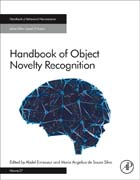
The recognition of objects in the surrounding environment plays an essential role for survival for humans and animals, and our environments are comprised of a wide variety of physical objects that we must recognize. How do we perceive these objects from various viewpoints, in unusual orientations, with varying background noise and at different scales, under partial occlusion or in different illuminations? How do we encode these objects, recognize them, and ultimately remember them? For many years, tests of object recognition were limited to visual pattern discrimination and object-novelty induced neophobia, but in the past few decades, the object novelty recognition task has gained in popularity-the task is simple to administer, relies on spontaneous exploratory activity, and can be administered in the same way to rats, mice, non-human primates, and humans. Handbook of Object Novelty Recognition synthesizes the empirical and theoretical advances in the field of object recognition and memory since the development of the spontaneous object recognition task. The book is divided into four sections to cover all aspects of the memory of objects; the first covers vision and perception of object features and attributions, definitions of concepts that are associated with object recognition, descriptions of methods and techniques used to assess object recognition, and variants of the test. The second section discusses the influence of brain lesions and drugs on various memory functions and processes. The third covers models of neuropsychiatric disorders based on spontaneous object recognition tasks, and the final section covers genetic and developmental studies, as well as gender and hormone studies. Together, the chapters in Handbook of Object Novelty Recognition provide thorough coverage of the topic for students and researchers investigating all aspects of object memory. Details the brain structures and neural circuits that underlie memory of objects, including vision and olfaction, as well as coverage of how lesions, drugs, and other factors influence memoryProvides a thorough description of the object novelty recognition task, variations on the basic task, and methods and techniques to help researchers avoid common pitfalls associated with the taskAssists researchers in understanding all aspects of object memory, conducting object novelty recognition tests, and producing reliable, reproducible results INDICE: 1. Vision in Rats and Mice 2. Perception of Object Features and Discrimination 3. The Role of Olfaction and the Vibrissae in Object Recognition 4. Memory Tests: Methods and Test Procedures 5. Theories and Concepts 6. Object Recognition in Rats and Mice 7. Lesion Studies 8. Pharmacological Studies 9. Genetic Studies 10. Early-Gene Imaging Studies 11. Electrophysiology Studies 12. Substances of Abuse and Addiction 13. Schizophrenia 14. Alzheimer's Disease 15. Ischemia and Cerebral Hemorrhage 16. Developmental Studies 17. Sex and Hormones
- ISBN: 978-0-12-812012-5
- Editorial: Academic Press
- Encuadernacion: Cartoné
- Páginas: 400
- Fecha Publicación: 01/05/2018
- Nº Volúmenes: 1
- Idioma: Inglés
